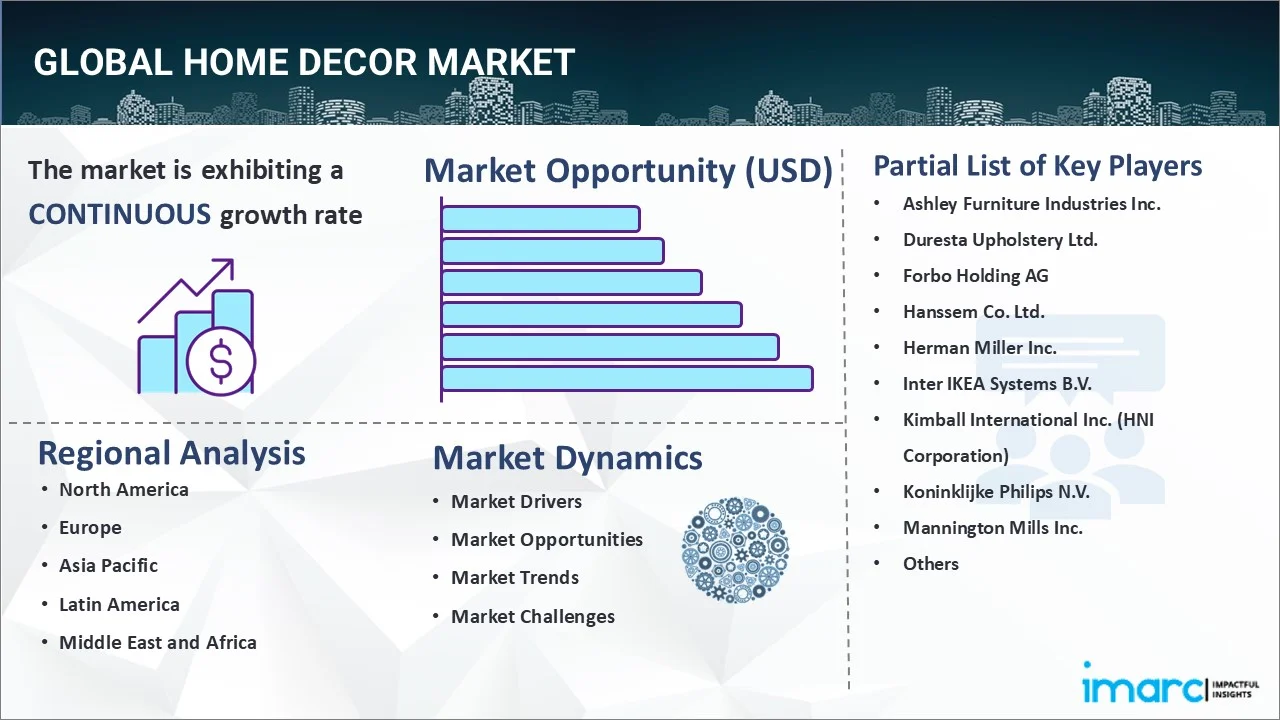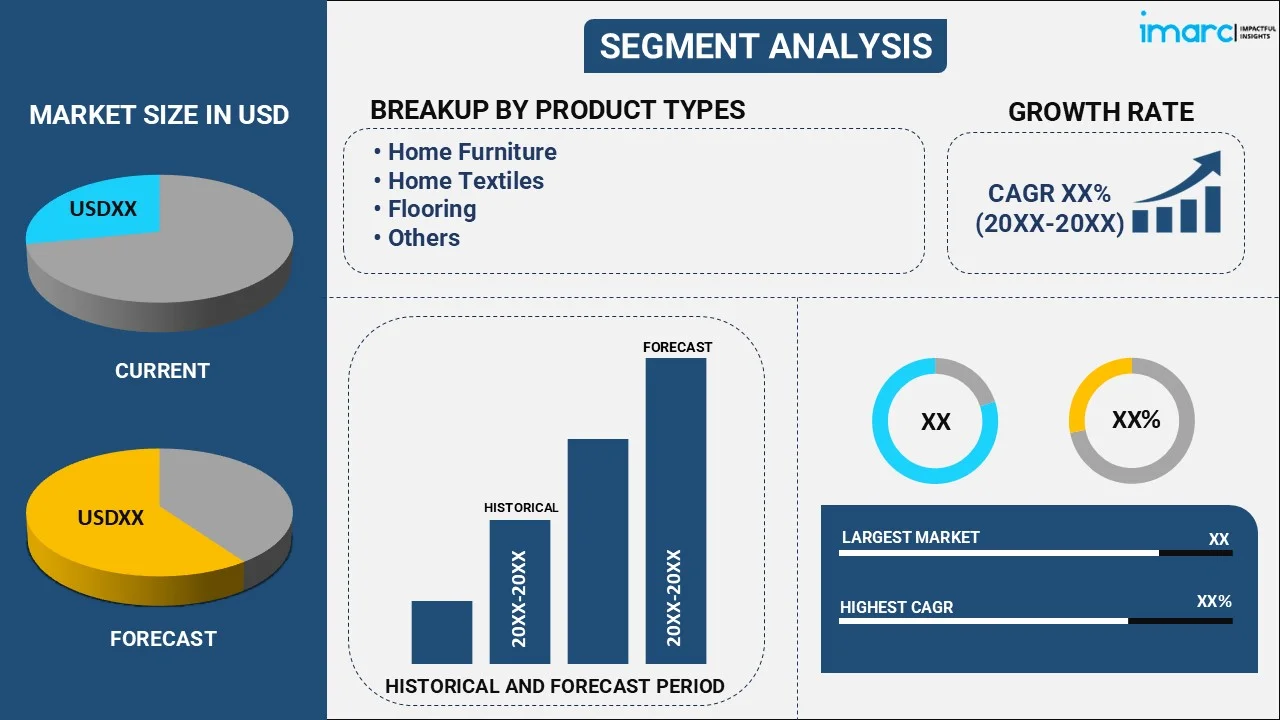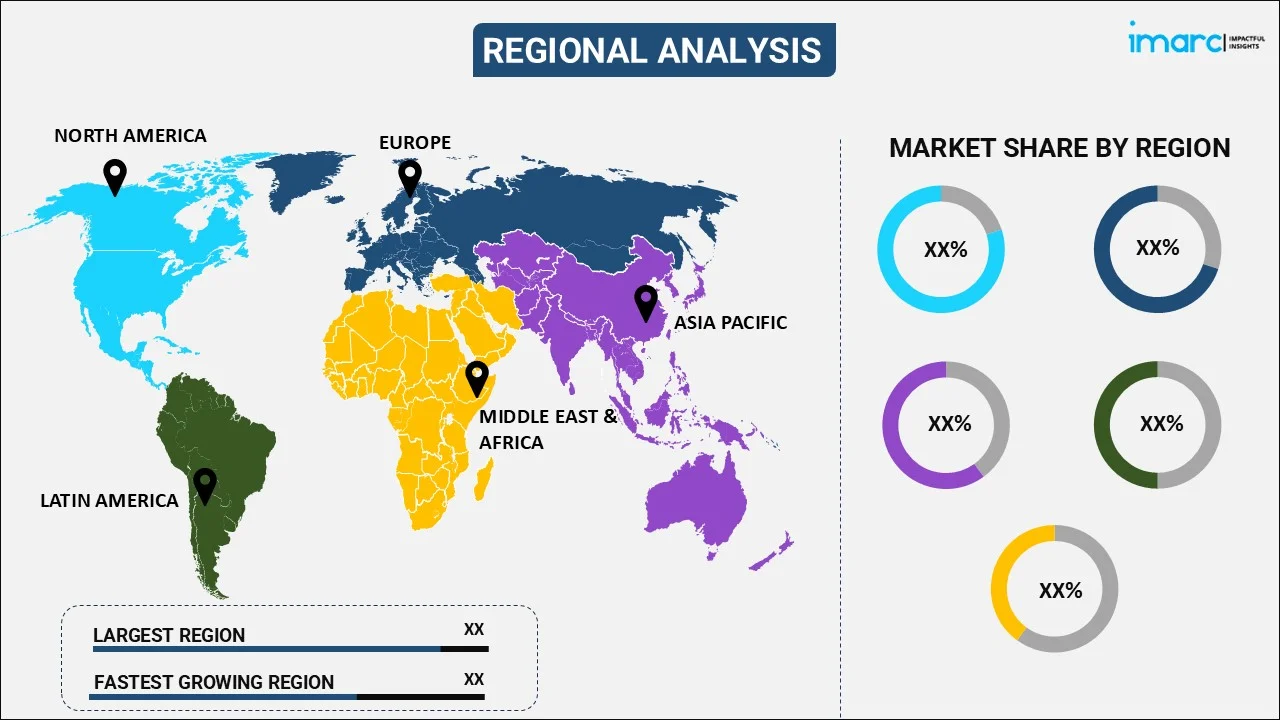
Home Decor Market Report by Product Type (Home Furniture, Home Textiles, Flooring, Wall Decor, Lighting, and Others), Distribution Channel (Home Décor Stores, Supermarkets and Hypermarkets, Online Stores, and Others), and Region 2025-2033
Home Decor Market 2024, Size and Trends:
The global home decor market size reached USD 779.8 Billion in 2024. Looking forward, IMARC Group expects the market to reach USD 1,104.0 Billion by 2033, exhibiting a growth rate (CAGR) of 3.9% during 2025-2033. The market is experiencing stable growth driven by the increasing focus on health and wellness, rising preferences for personalized and aesthetically pleasing interior designs, and integration of smart technology in decor products to provide enhanced experiences to individuals.
|
Report Attribute
|
Key Statistics
|
|---|---|
|
Base Year
|
2024
|
|
Forecast Years
|
2025-2033
|
|
Historical Years
|
2019-2024
|
|
Market Size in 2024
|
USD 779.8 Billion |
|
Market Forecast in 2033
|
USD 1,104.0 Billion |
| Market Growth Rate 2025-2033 | 3.9% |
Home Decor Market Analysis:
- Market Growth and Size: The market is witnessing moderate growth on account of the escalating demand for space-saving solutions, along with the increasing trend of do-it-yourself (DIY) among individuals.
- Technological Advancements: Innovations, such as augmented reality (AR) and virtual reality (VR), for visualizing decor products and the integration of smart home technology into decor items, are strengthening the market growth.
- Industry Applications: The home decor market caters to various applications, including residential, commercial, and hospitality.
- Geographical Trends: North America leads the market on account of the rising desire to create aesthetically pleasing and comfortable living environments. However, Asia Pacific is emerging as a fast-growing market due to the escalating demand for environmentally responsible and ethically sourced decor products.
- Competitive Landscape: Key players are focusing on maintaining sustainability by using eco-friendly materials, reducing waste, and adopting responsible manufacturing practices.
- Challenges and Opportunities: While the market faces challenges, such as the increasing need to meet sustainability standards, it also encounters opportunities due to the rising demand for personalized products.
- Future Outlook: The future of the home decor market looks promising, with the escalating demand for attractive decor items in homes. Moreover, the rising focus on eco-friendly decor items is expected to propel the market growth.

Home Decor Market Trends:
Rising preferences for personalization
The escalating demand for decor items for homes due to changing preferences of individuals is supporting the growth of the market. In line with this, rising preferences for personalized and aesthetically pleasing interior designs among the masses across the globe. Moreover, people are increasingly seeking unique and customized decor items that reflect their personality and style. Besides this, the increasing focus on handmade and artisanal decor products is impelling the market growth. Additionally, the growing demand for decor items that are manufactured from sustainable materials is offering a positive market outlook. Apart from this, the escalating demand for decor products on account of the rising social media influence on people is bolstering the market growth. Furthermore, various social media platforms showcase inspirational interior designs, encouraging individuals to purchase similar decor elements. Moreover, the increasing adoption of decor items with minimalist designs, vintage aesthetics, or eco-friendly options is contributing to the market growth.
Growing focus on health and wellness
Health-conscious consumers are opting for home decor items made from natural and sustainable materials. In addition, people are preferring materials like bamboo, reclaimed wood, organic cotton, and eco-friendly paints as they reduce exposure to harmful chemicals and promote a healthier indoor environment. Apart from this, biophilic design approach incorporates natural elements like plants, natural light, and natural textures into interior spaces. Biophilic design is known to reduce stress and enhance overall well-being. Furthermore, the rising need for ergonomics and comfortable products among individuals is propelling the market growth. In addition, there is an increase in the demand for furniture and accessories that are designed to support good posture and reduce physical strain. Furthermore, circadian lighting systems, which mimic natural daylight patterns, help regulate sleep patterns and enhance mood. In line with this, smart lighting control systems allow for personalized lighting experiences. Moreover, decor items include storage solutions and furniture designs that promote tidiness and reduce visual clutter.
Increasing integration of smart technology
Integration of smart technology in decor products assists in providing enhanced experiences to individuals. In addition, it offers improved convenience and control. Homeowners can manage various aspects of their living environment with ease, ranging from lighting and thermostats to voice-activated assistants and motorized window shades. This level of control benefits in enhancing comfort and efficiency. Apart from this, smart decor items contribute to energy efficiency by allowing users to monitor and optimize energy consumption. Smart lighting systems can automatically adjust brightness based on natural light levels, reducing electricity usage and lowering energy bills. Additionally, smart technology enables personalization and allows users to customize lighting colors, brightness levels, and patterns to match their mood or occasion. Furthermore, voice-activated assistants provide personalized assistance and information. Smart decor products often include security features like connected cameras, doorbell cameras, and smart locks. These enhance home security and offer peace of mind to homeowners, allowing them to monitor their properties remotely.
Home Decor Industry Segmentation:
IMARC Group provides an analysis of the key trends in each segment of the market, along with forecasts at the global and regional levels for 2025-2033. Our report has categorized the market based on product type and distribution channel.
Breakup by Product Type:

- Home Furniture
- Home Textiles
- Flooring
- Wall Decor
- Lighting
- Others
Home furniture accounts for the majority of the market share
The report has provided a detailed breakup and analysis of the home decor industry based on the product type. This includes home furniture, home textiles, flooring, wall decor, lighting, and others. According to the report, home furniture represented the largest segment.
Home furniture includes numerous items, such as sofas, chairs, tables, beds, cabinets, and other furniture pieces, used for functional and decorative purposes. In line with this, people are increasingly investing in high-quality furniture to enhance the aesthetics and functionality of their homes.
Home textiles encompass a wide range of products, including curtains, drapes, bedding, cushions, rugs, and towels. These items add texture, color, and warmth to interior spaces. In addition, the growing demand for attractive home textiles among individuals is propelling the market growth.
Flooring materials and solutions are essential components that include hardwood flooring, carpeting, tiles, laminate, and vinyl. Apart from this, flooring choices play a pivotal role in defining the overall style and ambiance of a room.
Wall decor products include artwork, mirrors, wall clocks, decals, and wallpaper. Wall decor is a versatile category that allows individuals to personalize their living spaces and create focal points within rooms.
Lighting fixtures and solutions are integral to home decor and comprise chandeliers, pendant lights, floor lamps, table lamps, and light-emitting diode (LED) lighting options. In line with this, lighting not only serves functional purposes but also contributes to the ambiance of a space.
Breakup by Distribution Channel:
- Home Decor Stores
- Supermarkets and Hypermarkets
- Online Store
- Gift Shops
- Others
Home decor stores hold the largest market share
A detailed breakup and analysis of the market based on the distribution channel have also been provided in the report. This includes home decor stores, supermarkets and hypermarkets, online store, gift shops, and others. According to the report, home decor stores accounted for the largest market share.
Home decor stores are retail outlets that exclusively sell decor products. These stores offer a wide selection of furniture, textiles, wall decor, and lighting, allowing individuals to physically inspect and purchase items. They also provide expert assistance and design consultations to help people make informed choices.
Supermarkets and hypermarkets have different sections for decor products. These stores offer convenience and accessibility, making it easy for shoppers to pick up decor items while doing their regular grocery shopping. While the selection may be more limited as compared to specialized decor stores, they cater to a broad consumer seeking budget-friendly options.
Online stores provide individuals with a vast array of decor products. In addition, they allow individuals to browse, compare, and purchase items from the comfort of their homes. The online channel offers convenience, a wide range of choices, and often includes reviews and recommendations from individuals.
Gift shops feature a selection of decor items, particularly those with unique or artisanal designs. Apart from this, these shops are suitable for individuals seeking distinctive and handcrafted decor products.
Breakup by Region:

- North America
- Europe
- Asia Pacific
- Middle East and Africa
- Latin America
North America leads the market, accounting for the largest home decor market share
The home decor market research report has also provided a comprehensive analysis of all the major regional markets, which include North America, Europe, Asia Pacific, the Middle East and Africa, and Latin America. According to the report, North America accounted for the largest market share due to the rising focus on interior design and home improvement solutions among individuals. In line with this, the increasing desire to create aesthetically pleasing and comfortable living environments is supporting the growth of the market. Furthermore, the presence of well-established online retail platforms that offer wide selections of decor products is bolstering the market growth. Besides this, the presence of key manufacturers, retailers, and designers in the region is impelling the market growth.
Asia Pacific stands as another key region in the market as it has a rich heritage of craftsmanship and artisanal traditions. In addition, the rising focus on improving living spaces due to inflating income levels of individuals in the region is contributing to the growth of the market. Apart from this, increasing preferences for online platforms for purchasing decor items, as they provide an easy access to a vast selection of products, is bolstering the growth of the market. Additionally, the growing demand for environmentally responsible and ethically sourced decor products is offering a positive market outlook.
Europe maintains a strong presence in the market, with the rising focus on sustainable and eco-friendly products among the masses. In line with this, Europe has a well-developed retail infrastructure, including boutique stores, designer showrooms, and established e-commerce platforms, that provides individuals with a diverse and accessible range of decor options. Moreover, the increasing adoption of aesthetically pleasing decorative products is supporting the market growth in the region.
The Middle East and Africa region shows a developing market due to the rising spending on luxury and high-quality decor items. Moreover, the increasing focus on enhancing living spaces with stylish and functional furnishings and decor items is contributing to the growth of the market. In addition, the growing demand for decor items in hotels, resorts, and luxury accommodations is positively influencing the market in the region.
Latin America exhibits growing potential in the market on account of the wide availability of decor items through online and offline distribution channels. Apart from this, rising preferences for sustainable and eco-friendly decor options among the masses in the region is propelling the market growth.
Leading Key Players in the Home Decor Industry:
Key players are expanding their product portfolios for catering to the wide range of needs and preferences of individuals. This includes introducing new designs, styles, and categories, such as sustainable products and smart home integration. They are focusing on maintaining sustainability by using eco-friendly materials, reducing waste, and adopting responsible manufacturing practices. For instance, in September 2024, IKEA announced the launch of PAX wardrobe with a recyclable and innovative frame for quicker assembly and enhanced access. In addition, companies are increasingly focusing on their online presence and e-commerce capabilities. They are investing in user-friendly websites, mobile apps, and online marketplaces to reach a broader customer base and provide a seamless shopping experience. Apart from this, major manufacturers are offering personalized items by providing different colors and patterns in furniture and decor pieces. Furthermore, companies are integrating technology, such as smart lighting, thermostats, and voice-controlled devices. These innovations cater to individuals looking for convenience and modernity in their living spaces.
The market research report has provided a comprehensive analysis of the competitive landscape. Detailed profiles of all major companies have also been provided. Some of the key players in the market include:
- Ashley Furniture Industries Inc.
- Duresta Upholstery Ltd.
- Forbo Holding AG
- Hanssem Co. Ltd.
- Herman Miller Inc.
- Inter IKEA Systems B.V.
- Kimball International Inc. (HNI Corporation)
- Koninklijke Philips N.V.
- Mannington Mills Inc.
- Mohawk Industries Inc.
- Samson Holding Ltd.
- Shaw Industries Group Inc. (Berkshire Hathaway Inc.)
- Sophia Home
- Springs Window Fashions
- Suofeiya Home Collection Co. Ltd.
(Please note that this is only a partial list of the key players, and the complete list is provided in the report.)
Latest News:
- July 20, 2022: Inter IKEA Systems B.V., the leading Swedish home furnishings retailer, will open its third store in Mumbai at R CITY, Ghatkopar (W). This will strengthen the commitment of the company to India, making the brand more accessible to a larger consumer base.
- August 21, 2023: Herman Miller Inc introduced fuld nesting chair designed in collaboration with Stefan Diez. It has a sleek design that enables flexible configurations for workspaces. Available in dipped-in-color options consisting of the seat, seat-back, and legs in one hue and dual-color combinations.
- March, 2021: Ashley Furniture Industries Inc, the largest manufacturer of furniture in the world, announced plans to open a new facility near Pottsville, Pa. The 1.7 million-square-foot complex, which produces stationery upholstery furniture, will also tap into the capital investment to update the facility and cover machinery and equipment costs.
Home Decor Market Report Scope:
| Report Features | Details |
|---|---|
| Base Year of the Analysis | 2024 |
| Historical Period | 2019-2024 |
| Forecast Period | 2025-2033 |
| Units | Billion USD |
| Scope of the Report | Exploration of Historical Trends and Market Outlook, Industry Catalysts and Challenges, Segment-Wise Historical and Future Market Assessment:
|
| Product Types Covered | Home Furniture, Home Textiles, Flooring, Wall Decor, Lighting, Others |
| Distribution Channels Covered | Home Decor Stores, Supermarkets and Hypermarkets, Online Store, Gift Shops, Others |
| Regions Covered | Asia Pacific, Europe, North America, Latin America, Middle East and Africa |
| Companies Covered | Ashley Furniture Industries Inc., Duresta Upholstery Ltd., Forbo Holding AG, Hanssem Co. Ltd., Herman Miller Inc., Inter IKEA Systems B.V., Kimball International Inc. (HNI Corporation), Koninklijke Philips N.V., Mannington Mills Inc., Mohawk Industries Inc., Samson Holding Ltd., Shaw Industries Group Inc. (Berkshire Hathaway Inc.), Sophia Home, Springs Window Fashions, Suofeiya Home Collection Co. Ltd., etc. |
| Customization Scope | 10% Free Customization |
| Post-Sale Analyst Support | 10-12 Weeks |
| Delivery Format | PDF and Excel through Email (We can also provide the editable version of the report in PPT/Word format on special request) |
Key Benefits for Stakeholders:
- IMARC’s industry report offers a comprehensive quantitative analysis of various market segments, historical and current market trends, market forecasts, and dynamics of the home decor market from 2019-2033.
- The research report provides the latest information on the market drivers, challenges, and opportunities in the global home decor market 2024
- The study maps the leading, as well as the fastest-growing, regional markets.
- Porter's five forces analysis assists stakeholders in assessing the impact of new entrants, competitive rivalry, supplier power, buyer power, and the threat of substitution. It helps stakeholders to analyze the level of competition within the home decor industry and its attractiveness.
- The competitive landscape allows stakeholders to understand their competitive environment and provides insight into the current positions of key players in the market.
Key Questions Answered in This Report
The global home decor market was valued at USD 779.8 Billion in 2024.
The profitability of home decor business largely depends on product selection, pricing strategy, business management, and target market among other parameters.
IMARC Group expects the market to reach USD 1,104.0 Billion by 2033, exhibiting a growth rate (CAGR) of 3.9% during 2025-2033.
The expanding real estate sector, along with the rising popularity of eco-friendly home decor products, is primarily catalyzing the global home decor market.
The sudden outbreak of the COVID-19 pandemic has led to the shifting consumer inclination from conventional brick-and-mortar distribution channels towards online retail platforms for the purchase of home decor products.
Based on the product type, the global home decor market has been divided into home furniture, home textiles, flooring, wall decor, lighting, and others. Among these, home furniture exhibits a clear dominance in the market.
Based on the distribution channel, the global home decor market can be segmented into home décor stores, supermarkets and hypermarkets, online store, gift shops, and others. Currently, home décor stores account for the largest market share.
On a regional level, the market has been classified into North America, Asia Pacific, Europe, Latin America, and Middle East and Africa, where North America currently dominates the global market.
Some of the major players in the global home decor market include Ashley Furniture Industries Inc., Duresta Upholstery Ltd., Forbo Holding AG, Hanssem Co. Ltd., Herman Miller Inc., Inter IKEA Systems B.V., Kimball International Inc. (HNI Corporation), Koninklijke Philips N.V., Mannington Mills Inc., Mohawk Industries Inc., Samson Holding Ltd., Shaw Industries Group Inc. (Berkshire Hathaway Inc.), Sophia Home, Springs Window Fashions and Suofeiya Home Collection Co. Ltd.
Need more help?
- Speak to our experienced analysts for insights on the current market scenarios.
- Include additional segments and countries to customize the report as per your requirement.
- Gain an unparalleled competitive advantage in your domain by understanding how to utilize the report and positively impacting your operations and revenue.
- For further assistance, please connect with our analysts.
 Inquire Before Buying
Inquire Before Buying
 Speak to an Analyst
Speak to an Analyst
 Request Brochure
Request Brochure
 Request Customization
Request Customization




.webp)




.webp)












